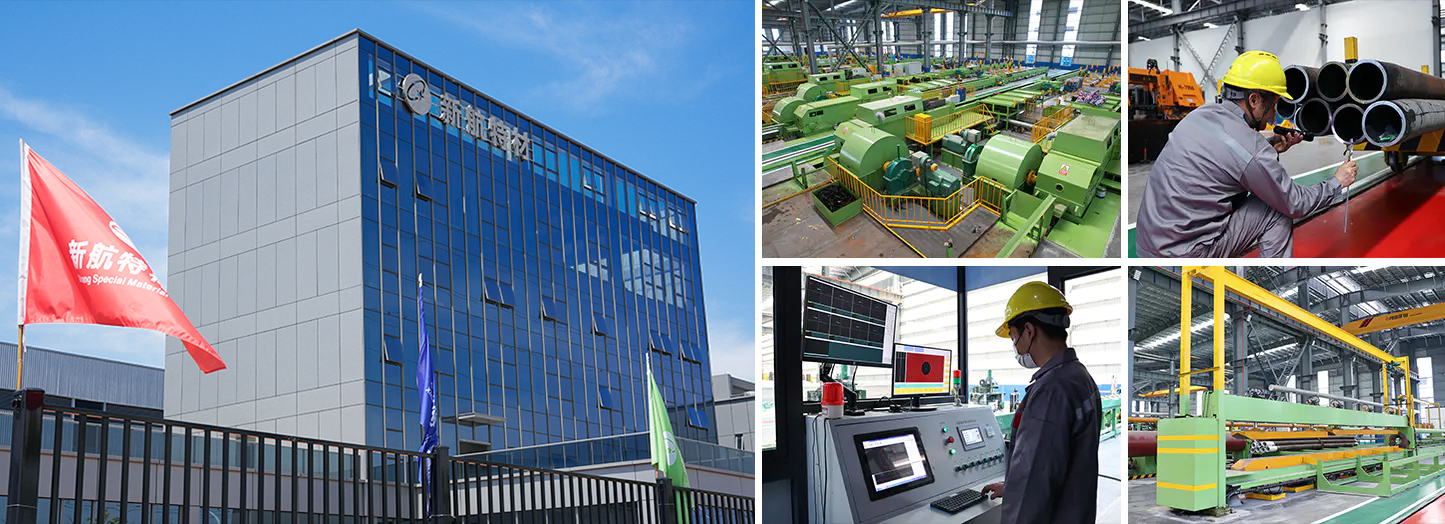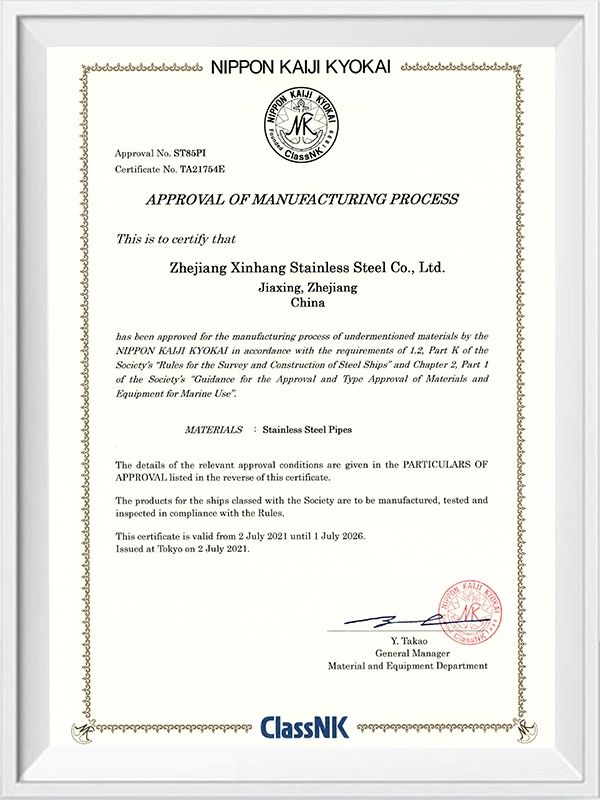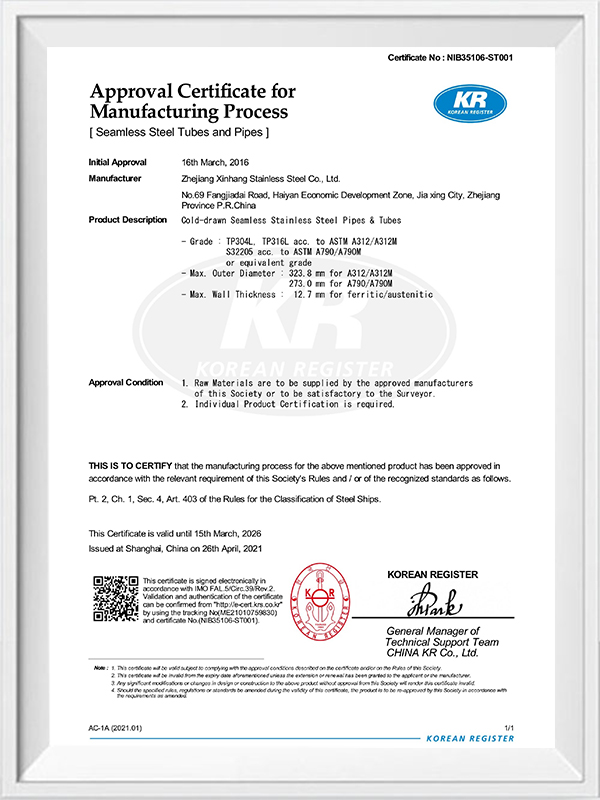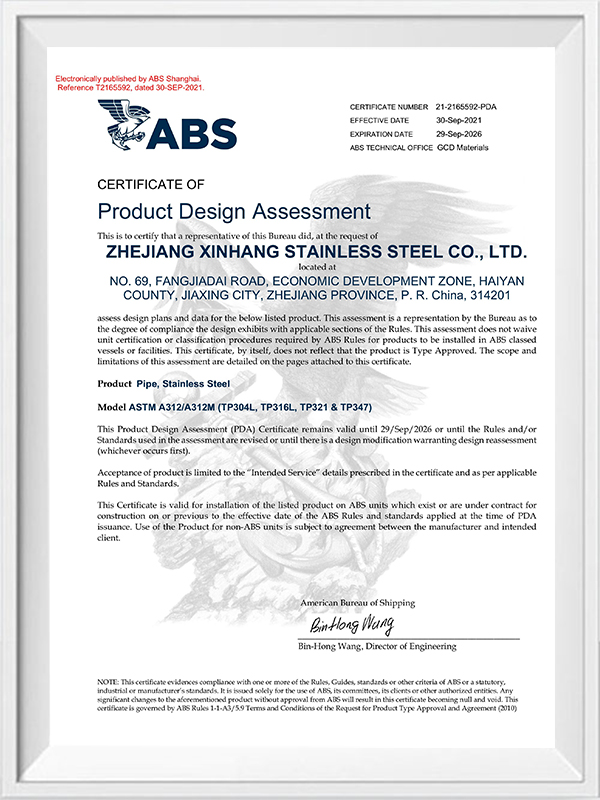

Xinhang Special Material Co., Ltd. Hangzhou Branch is China stainless steel pipe for gas Manufacturers and stainless steel pipe for gas Factory, founded in 2007 and moved to Longyou Economic Development Zone, Zhejiang Province, in 2022. It covers an area of 130,000 square meters, more than 30 production lines, 300 workers, 20 R&D people, 30 inspection people and an annual output of 50,000 tons.
It has passed ISO9001:2008 quality management system, PED 97/23/EC EU Pressure Equipment Directive certification, China Special Equipment Manufacturing License (Pressure Tube) TS certification, ASME certification, provincial enterprise standardization management system, ISO14000:2004 environment management system, cleaner production (green enterprise), and a series of certifications, as well as China Classification Society (CCS), American Bureau of Shipping (ABS), British Register of Shipping (LR), Deutsche Veritas (GL), Bureau Veritas Society (BV), Det Norske Veritas (DNV), and Korean Register of Shipping (KR) factory certification.
The main products include stainless steel pipes, pipe fittings, flanges, valves, etc., which are widely used in petroleum, chemical industry, nuclear industry, smelting, shipbuilding, pharmaceuticals, food, water conservancy, electric power, new energy, mechanical equipment, and other fields. The company adheres to the corporate tenet of "quality for survival, reputation for development" and wholeheartedly serves every customer to create a win-win situation.




Introduction to Alloy Steel Alloy steel is a type of steel that is made by combining carbon steel with various alloying ...
View MoreMass Density of Mild Steel: Basics and Practical Importance The mass density of mild steel is a fundamental property tha...
View MoreUnderstanding Stress Proof Steel Stress proof steel is a type of alloyed steel engineered to resist deformation under lo...
View MoreIntroduction to Low Alloy Steel Material Low alloy steel material is a type of steel that contains a small percentage of...
View MoreHow often should stainless steel gas pipes be inspected for safety compliance?
The frequency of inspections for stainless steel gas pipes depends on several factors, including regulatory requirements, environmental conditions, and the specific application. However, some general guidelines can be followed:
Regulatory Requirements: Check local or national regulations governing gas piping systems. They often outline the frequency and scope of inspections required to ensure compliance with safety standards.
Manufacturer Recommendations: Refer to the manufacturer's guidelines for the stainless steel pipes and any associated components. They may provide specific recommendations for inspection intervals and maintenance procedures.
Environmental Factors: Consider the environmental conditions that the gas piping system is exposed to. Harsh environments, such as coastal areas with high salt content in the air or industrial settings with corrosive substances, may necessitate more frequent inspections.
Usage Patterns: Evaluate the usage patterns of the gas piping system. High-traffic areas or systems subject to frequent temperature fluctuations or pressure changes may require more frequent inspections to ensure safety and reliability.
Previous Inspection Findings: Take into account any previous inspection findings or maintenance issues. If past inspections have revealed problems or concerns, more frequent inspections may be warranted to monitor the condition of the system and address any potential issues promptly.
How can one detect and address potential issues with stainless steel gas pipes, such as leaks or blockages?
Visual Inspection:Regularly inspect stainless steel gas pipes for signs of damage, corrosion, or wear.
Look for any visible leaks, including small cracks or holes, around pipe joints, fittings, or connections.
Check for discoloration, rust, or other indications of corrosion on the surface of the pipes.
Gas Leak Detection:Use a gas leak detector or a mixture of soap and water to check for leaks along the length of the pipe.
Look for bubbles forming at potential leak points when the detector or soapy water is applied.
Pay close attention to areas where pipes connect to appliances, valves, or fittings, as these are common locations for leaks to occur.
Pressure Testing:Conduct pressure tests on the gas piping system to identify any leaks or weaknesses.
Use pressure gauges and pressure testing equipment to pressurize the system and monitor for pressure drops, which can indicate leaks.
Follow recommended pressure testing procedures and safety precautions to ensure accurate results and prevent damage to the system.
Thermal Imaging:Utilize thermal imaging cameras to detect temperature anomalies along the surface of the pipes.
Temperature variations can indicate potential leaks or blockages, as well as areas of increased friction or stress.
Conduct thermal inspections regularly, especially in areas prone to temperature fluctuations or where gas flow is critical.
Routine Maintenance:Implement a regular maintenance schedule for the gas piping system, including cleaning, lubrication, and inspection of valves, fittings, and other components.
Replace worn or damaged parts promptly to prevent leaks or failures.
Keep vegetation, debris, and other obstructions away from outdoor piping to maintain clear access and visibility.
We'll never share your email address and you
can opt out at any time, we promise.